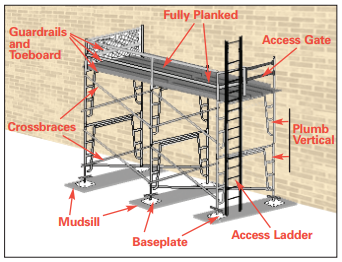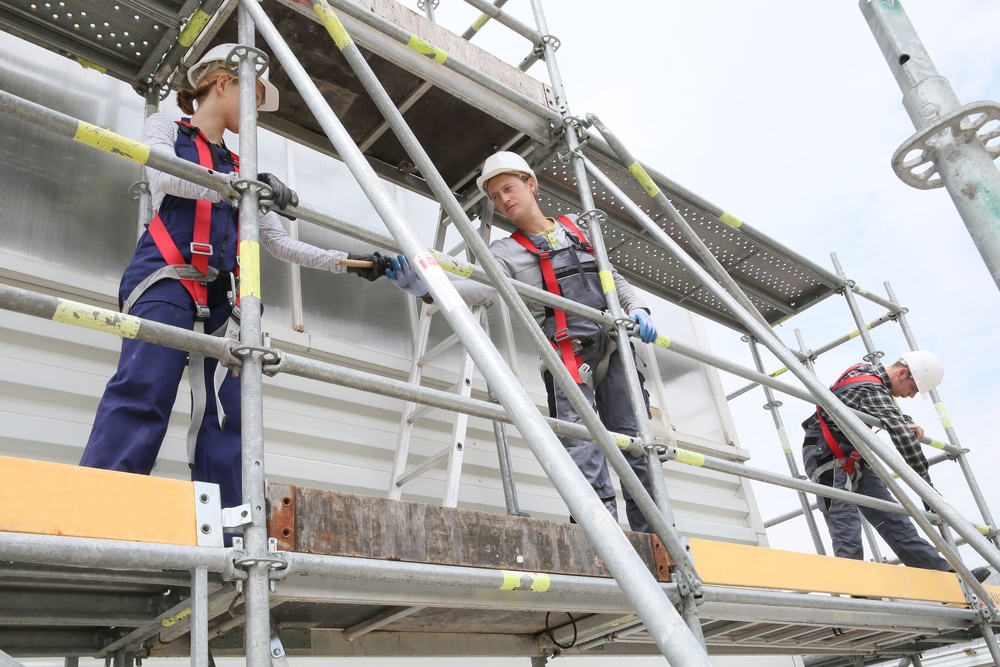Temporary Roof Scaffolding Experts Providing Secure and Reliable Installations
Temporary Roof Scaffolding Experts Providing Secure and Reliable Installations
Blog Article
Discovering the Different Kinds of Scaffolding Utilized in Building And Construction Jobs
The building sector counts greatly on different types of scaffolding to meet particular task needs, each offering distinct benefits and applications. Conventional structure scaffolding offers a strong foundation for general jobs, while suspended scaffolding is necessary for work on high-rise structures. Various other alternatives, such as system and rolling scaffolding, provide to efficiency and movement, respectively. The cantilever variant confirms very useful in city settings where space is constrained. Comprehending the nuances of these scaffolding kinds is important for optimizing safety and performance on construction sites, motivating a closer evaluation of their special attributes and applications.

Conventional Structure Scaffolding
Standard structure scaffolding is among one of the most widely used approaches in the building and construction sector as a result of its toughness and adaptability. This system contains straight and vertical frameworks that are put together to create a steady platform for materials and employees. The main parts consist of upright messages, straight journals, and angled dental braces, which with each other supply a solid structure that can support substantial lots.
Among the key advantages of traditional framework scaffolding is its versatility to different construction projects, varying from residential buildings to huge business structures. The modular style permits simple setting up and disassembly, making it reliable for both long-lasting and temporary projects. Additionally, the system can be tailored in height and size, suiting different building styles and site problems.
Safety and security is critical in scaffolding applications, and traditional frame systems are equipped with guardrails and toe boards to avoid falls and make sure employee protection. Furthermore, routine assessments and adherence to safety laws are vital in preserving the honesty of the scaffold. Generally, typical frame scaffolding continues to be a fundamental selection in the construction market, offering a trustworthy platform for labor and improving general task performance

Suspended Scaffolding
Put on hold scaffolding uses a distinct solution for construction projects that need accessibility to raised surface areas, specifically in situations where traditional frame scaffolding might be unwise. This sort of scaffolding is commonly suspended from the roofing or upper degrees of a framework, making use of a system of pulleys, systems, and ropes to create a working space that can be gotten used to numerous elevations.
Among the primary advantages of suspended scaffolding is its flexibility. It can be conveniently rearranged or reduced to fit modifications in building and construction requirements, making it suitable for tasks such as home window installment, façade work, and maintenance on high-rise structures. Additionally, the minimal impact of suspended scaffolding permits far better use of ground room in metropolitan atmospheres, where area is usually limited.
Safety and security is an important consideration in the use of put on hold scaffolding. Correct rigging and securing systems have to be utilized to make certain security and prevent accidents. Operators has to also be trained in the secure use like it of this equipment. On the whole, put on hold scaffolding offers a reliable and efficient solution for accessing hard-to-reach locations in various building circumstances, improving both performance and safety and security on website.
System Scaffolding
System scaffolding, often considered as a modern option in the scaffolding industry, consists of pre-engineered components that can be swiftly put together and adapted for various building and construction jobs. Scaffolding. This sort of scaffolding is identified by its modular design, which permits flexibility and efficiency on task websites, accommodating architectural demands and various heights
Normally made from high-strength steel or light weight aluminum, system scaffolding offers boosted sturdiness and security. The components consist of vertical articles, horizontal ledgers, and diagonal dental braces, which interconnect safely, making sure a durable framework. The layout commonly integrates standard fittings, simplifying setting up and disassembly processes, thus reducing labor time and prices.

Rolling Scaffolding
Moving scaffolding is weblink a versatile option to typical fixed scaffolding, made for flexibility and simplicity of usage on construction sites. This sort of scaffolding includes a system sustained by structures with wheels, permitting employees to easily relocate it as required. The movement function dramatically improves productivity, as it decreases downtime linked with assembling and taking apart repaired scaffolding.
Normally built from light-weight products such as aluminum or steel, rolling scaffolding provides a sturdy yet portable remedy for projects needing frequent repositioning - Scaffolding. It is particularly helpful in jobs such as paint, drywall installation, and electric job, where accessibility to numerous heights and places is needed
Safety is paramount in rolling scaffolding style, with attributes such as securing wheels to stop unintended movement when in usage, and great site guardrails to protect employees from falls. Additionally, several models are adjustable in height, accommodating different project requirements.
Cantilever Scaffolding

The style of cantilever scaffolding usually includes using braces or arms anchored to a structure or structure, making it possible for the system to extend exterior safely. Security is vital; therefore, these scaffolds have to be crafted to endure ecological problems and various tons. Regular examination and upkeep are vital to make certain architectural integrity and employee safety.
Cantilever scaffolding is favored for its versatility and efficient use space, making it a prominent selection in urban settings where room restrictions are usual. In addition, it promotes much easier accessibility to high elevations, eventually adding to the general effectiveness of building and construction jobs. Similar to all scaffolding types, correct training and adherence to safety and security standards are essential for employees making use of cantilever scaffolding.
Final Thought
Standard structure scaffolding offers security, while put on hold scaffolding supplies adaptability for elevated jobs. System scaffolding assists in quick setting up, and rolling scaffolding improves flexibility for differing job environments.
Standard frame scaffolding supplies a tough structure for general tasks, while put on hold scaffolding is important for job on high-rise structures.Moving scaffolding is a flexible choice to traditional fixed scaffolding, made for flexibility and ease of use on construction sites. As with all scaffolding kinds, correct training and adherence to security criteria are critical for workers utilizing cantilever scaffolding.
Standard structure scaffolding offers security, while put on hold scaffolding offers versatility for elevated tasks. System scaffolding facilitates fast assembly, and rolling scaffolding improves mobility for differing work environments.
Report this page